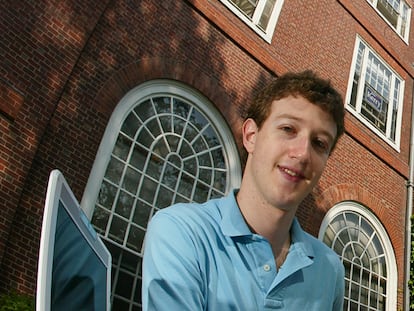Willy Chavarria: ‘I designed a shirt with the USA logo upside-down to express how screwed this country is’
The most prominent Latino in the fashion world founded his eponymous brand in 2015 and has become a cultural agitator in the name of two communities with an at-times uneasy overlap: Hispanics and queers

Mexican American fashion designer Willy Chavarria, 57, has made a name for himself in the world of New York fashion. Last year, he received the yearly award for American Menswear Designer from the Council of Fashion Designers of America (CFDA), the foremost fashion organization in North America. “It’s a recognition that tells me a lot about the future. Though I have the honor of being the first Latino to receive it, there will be many more to come,” he said on a videocall from his studio in Brooklyn. He wears a black shirt and pants, his fingers covered in rings, his neck covered in necklaces, his arms covered in tattoos; in true Mexican style, his hair is slicked back.
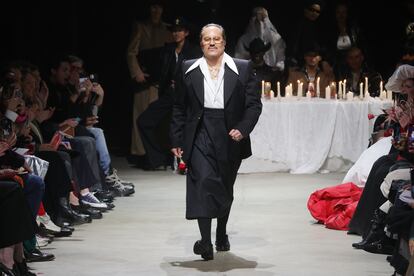
Chavarria launched his brand nine years ago and was the senior vice president of design at Calvin Klein since 2021 and until the beginning of 2024, when he left the position to focus on his own line. “Calvin is one of the great U.S. designers, so when they sought me out it was ‘wow.’ I always felt very identified with the brand. I make clothes so that people feel better about themselves,” he says.
Influenced by creators like Claude Montana and Yves Saint Laurent, Chavarria’s resume includes past posts in the design departments of Joe Boxer, Ralph Lauren and American Eagle. He has drawn from the style of groups like the pachucos and the cholos, who have been harshly marginalized, to honor his roots and present a new kind of product. “What could be more elegant than a white shirt, ironed and fitted, combined with khaki-colored pants, shiny black shoes and shaved head? The pachucos represent the perfect Latino man, and I like to appropriate that aspect of my culture and make it more queer. A Latinx in essence, respecting the influences that come my way and expressing myself at a level that was not accepted 50 years ago (…) My creative challenge is mixing the universe of a series like Griselda with another like Feud: Capote vs. The Swans,” he explains. His look at the 2024 Met Gala is the perfect illustration.

Question. When was your fascination with fashion and style born?
Answer. I grew up in an agricultural community of people who came from Mexico to work in the fields. As a result, my life vision was very limited, but I was obsessed with how everyone dressed. I paid a lot of attention to how men looked when they went to work and afterwards, when they would change to go out at night and go to mass, and women when they got dressed up for weddings. I studied graphic design because I thought that was my path. I began working in a warehouse, in the shipping department for the Joe Boxer brand, but soon I got an internship in the design department and everything started lighting up for me. My first designs were underwear. In that time, I was very involved in the San Francisco nightlife scene, which was a source of a lot of inspiration for what came later.
Q. That was how you came out of the closet…
A. Yes, in that era I literally came out of the closet, I had to spread my wings because at home, I never felt free. I was quiet, observant and a little depressed. I always knew I wanted to get to the top. Living in San Francisco, I dedicated myself to exploring everything. I moved from place to place and I was homeless for a while, until I came to live in a monastery. A pastor tried to perform an exorcism on me. It sounds like a movie, in fact I’d love to make one about it, but it’s real. I spent that time questioning my sexuality. I thought, I’m going to hell! [He cackles]

Q. How did you wind up in a monastery?
A. I was living on the streets in Boston and I met a pastor who let me live in his house with his wife, and I took care of the kids. Every night, we talked about a connection with God. ‘I don’t have all the answers for you,’ he told me. That’s how I got to the monastery, and I found out all the gays were there.
Q. As the son of a Mexican father and Irish working-class mother, did you run into racism or classism in the fashion industry?
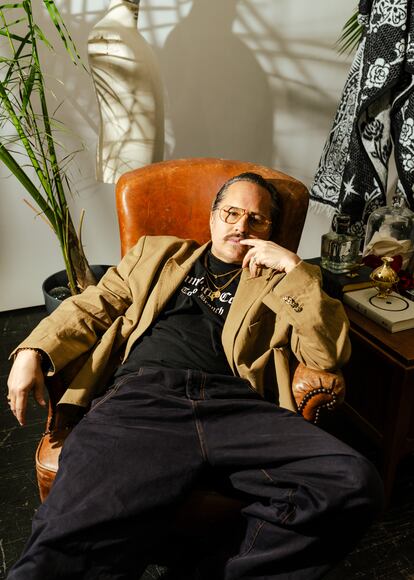
Q. Definitely, yes. Just because of the socioeconomic aspect of being Latino, I was not in a position where I could aspire to a career in fashion, even though I was as capable as the rest. I have cousins and friends who never felt capable of leaving Fresno, and the reason for that was very tied to United States racism. It was after 2020 that I saw more doors open up. My 2017 fall-winter runway show was very political. It coincided with the moment of the Donald Trump presidency, when they began to separate mothers from their children at the border, and put children in cages. Many people told me not to do it, because it was the kind of thing Anna Wintour (the all-powerful editor of the U.S. edition of Vogue) didn’t like, but I did it anyway. People felt connected.
Q. You’ve been inspired by the style of pachucos and cholos in the creation of your luxury brand. Still, you’ve said that you’re interested in promoting a different kind of exclusivity. What is luxury to you?
A. Luxury is connected to craft, materials, and the way of manufacturing a product, which ends up being expensive, because that process costs money. But the idea of luxury is also associated with status. Brands that sell you a denim jacket for three or four thousand dollars for you to think that you’re worth more if you use that item that cost you a fortune. That’s not luxury… I think that there should be a certain feeling of exclusivity and sense of belonging for people to want something, but all these concepts are changing.
Q. What is the Latinidad that you are interested in projecting now that your brand is more established?
A. For many years, we’ve seen Latin culture through the eyes of the oppressor. Right now is a beautiful moment, because many Latin artists in the United States are showing things from another dimension. Even two Latinos like Óscar de la Renta and Carolina Herrera, who have very different visions compared to mine, had to assimilate and make concessions to achieve success. I am aware that I have to be on friendly terms with Anna Wintour… She’s very powerful in this industry. I have to keep doing my thing in a very nice way.
Q. What is your view of the fashion industry? Brands seem very similar, few things truly surprise…
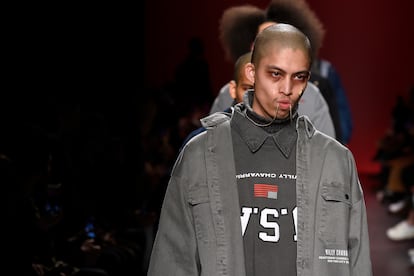
A. There’s definitely a problem and it’s the result of capitalism. There’s so much clothing and so many brands and everyone is trying to make as much money as they can, especially in the United States. People are afraid of taking risks, but I think that leaves space for new people to come in. I also think that the industry remains in the hands of the old guard, who are using the same formula over and over, and the moment has arrived for an update.
Q. Up to what point is it important to develop a queer narrative?
A. Everything I do comes from a queer perspective. So naturally, that translates to my designs, but I think it’s important to elevate the message. That is one of the reasons why I like to make high-end collections. I want to see Mexicans wearing luxury clothes, trans people wearing luxury clothes.
Q. Celebrities like Tokischa, Bad Bunny, Kendrick Lamar and Sam Smith have worn your brand. How hard is it to have them as clients?
A. With some celebrities it’s more complex, because they don’t always come ‘wanting it,’ but it has been beautiful to work with A-list stars. Above all, that many of these artists are embracing a brand that has such a queer identity as mine does. I’ve never experienced any kind of homophobia with any of them.
Q. In one of your castings, you hired an Uber Eats worker as a model and you’ve also hired undocumented immigrants. Where does your interest in working with regular people come from?
A. The majority of the models I work with are everyday people from New York. The young man you mentioned, I met while he was delivering an order, and he was so beautiful, I thought: ‘Oh my God, he would be incredible for the campaign.’ He came to the casting with his mother, and of course we hired him. He’s Colombian and is now signed to a modeling agency.
Q. You named your spring-summer 2024 collection New Life. What were you thinking about when you were designing it?
A. Of the necessity to be reborn, to retake the idea that, with spring, we can see ourselves in a different way. Still, I think that we are all a little bit depressed right now with what is happening in the world….
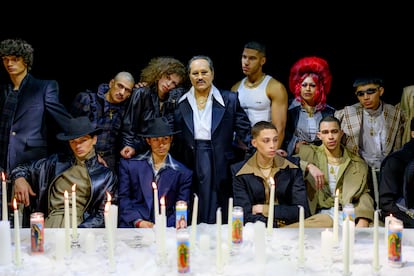
Q. Once again, you included a shirt with an upside-down ‘USA’ logo. What does that aesthetic gesture mean?
A. This year we have elections and I wonder what will happen if Trump returns to the presidency. It would be terrifying, terrible for democracy. So, I put the letters USA upside-down to express how screwed this country is. Everything is completely upside-down and screwed in this moment. That is exactly what it means.
Sign up for our weekly newsletter to get more English-language news coverage from EL PAÍS USA Edition
Tu suscripción se está usando en otro dispositivo
¿Quieres añadir otro usuario a tu suscripción?
Si continúas leyendo en este dispositivo, no se podrá leer en el otro.
FlechaTu suscripción se está usando en otro dispositivo y solo puedes acceder a EL PAÍS desde un dispositivo a la vez.
Si quieres compartir tu cuenta, cambia tu suscripción a la modalidad Premium, así podrás añadir otro usuario. Cada uno accederá con su propia cuenta de email, lo que os permitirá personalizar vuestra experiencia en EL PAÍS.
¿Tienes una suscripción de empresa? Accede aquí para contratar más cuentas.
En el caso de no saber quién está usando tu cuenta, te recomendamos cambiar tu contraseña aquí.
Si decides continuar compartiendo tu cuenta, este mensaje se mostrará en tu dispositivo y en el de la otra persona que está usando tu cuenta de forma indefinida, afectando a tu experiencia de lectura. Puedes consultar aquí los términos y condiciones de la suscripción digital.
More information
Archived In
Últimas noticias
Most viewed
- Sinaloa Cartel war is taking its toll on Los Chapitos
- Oona Chaplin: ‘I told James Cameron that I was living in a treehouse and starting a permaculture project with a friend’
- Reinhard Genzel, Nobel laureate in physics: ‘One-minute videos will never give you the truth’
- Why the price of coffee has skyrocketed: from Brazilian plantations to specialty coffee houses
- Silver prices are going crazy: This is what’s fueling the rally

